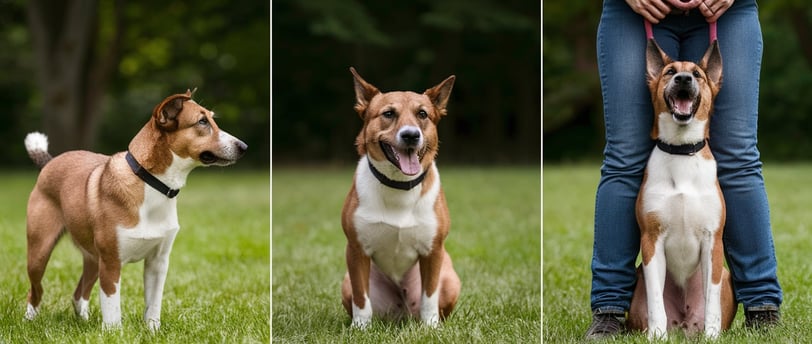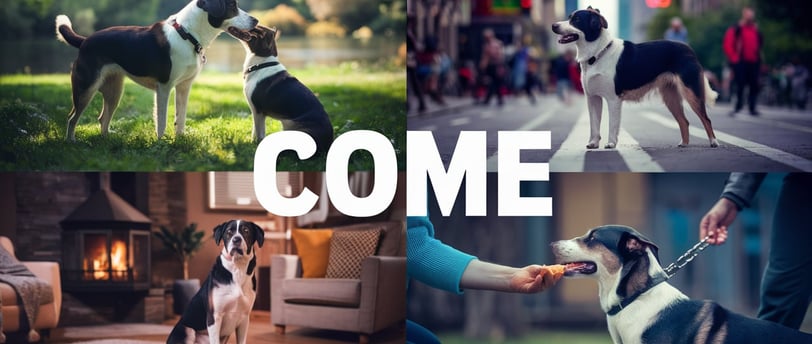The 'Come' Command for Dogs: Your Key to Stress-Free Walks and Park Visits
Master the "come" command to enhance your outdoor adventures and ensure your dog's safety. Our guide provides easy techniques for teaching reliable recall, suitable for any age or breed. Say goodbye to chaotic park chases and hello to enjoyable walks, strengthening your bond with every outing. Transform your experience today!
The Canine Chronicles
7/18/20245 min read


Over the years, I've helped countless dog owners train their pets to respond promptly to the 'come' command. It's a fundamental aspect of dog training that not only enhances safety but also strengthens the bond between you and your canine companion. In this article, I'll share my tried-and-true methods for teaching the 'come' command to dogs, along with some insider tips to make the process smoother and more effective.
Why the 'Come' Command is Essential
Before we dive into the training techniques, let's understand why the 'come' command is so important. A dog that reliably comes when called is:
Less likely to run into dangerous situations
Easier to manage in off-leash areas
More enjoyable to take on walks and outings
Better behaved around other people and animals
In my experience, dogs who have mastered the 'come' command are generally more confident and have a stronger connection with their owners. This command forms the foundation of a well-behaved and trustworthy canine companion.
Starting with the Basics: How to Train the 'Come' Command for Dogs
When it comes to dog training, the 'come' command is one of the first things I teach. Here's my step-by-step approach:
Choose a quiet, distraction-free environment to start.
Have your dog's favorite treats ready.
Say your dog's name followed by "come" in a cheerful, inviting tone.
When your dog moves towards you, praise enthusiastically.
As soon as your dog reaches you, reward with a treat and lots of affection.
Repeat this process several times in short training sessions.
Remember, consistency is key when training the 'come' command for dogs. Practice in various locations and gradually introduce distractions as your dog improves.
As a dog trainer with years of experience,
I can confidently say that mastering the 'come' command for dogs is one of the most crucial skills for any pet owner.
Whether you're enjoying a leisurely stroll in the neighborhood or playing fetch at the local park, a reliable recall can make all the difference in keeping your furry friend safe and your outings stress-free.


Advanced Techniques for a Rock-Solid Recall
Once your dog has grasped the basics of the 'come' command, it's time to up the ante. Here are some advanced techniques I use to reinforce this crucial skill:
The "Hide and Seek" Game: This fun activity strengthens the 'come' command while making training enjoyable for your dog.
Long-Line Training: Using a long leash allows your dog more freedom while ensuring safety during practice.
Distraction Training: Gradually introduce distractions to test and improve your dog's response to the 'come' command.
Random Rewards: Occasionally giving extra-special treats for a quick response keeps your dog eager to come when called.
Common Challenges in Dog Training: Come Command
Even with the best techniques, you might encounter some hurdles when training the 'come' command. Here are a few issues I've helped many dog owners overcome:
Inconsistent Response: Ensure all family members use the same command and reward system.
Overuse of the Command: Avoid calling your dog for unpleasant experiences like baths or nail trims.
Lack of Patience: Remember, mastering the 'come' command takes time and consistent practice.
Insufficient Rewards: Make coming to you the best thing your dog can do by using high-value treats and enthusiastic praise.
Real-Life Applications of the 'Come' Command
The true test of your dog training efforts comes in real-world situations. Here's how a well-trained 'come' command can make your life easier:
At the dog park, you can easily recall your dog if a situation becomes tense.
During walks, you can quickly bring your dog to heel if a car or bicycle approaches.
In case of emergencies, like a dropped leash, you can swiftly bring your dog back to safety.
Maintaining and Reinforcing the 'Come' Command
Training doesn't stop once your dog has learned the 'come' command. To ensure long-term success, I recommend:
Regular practice sessions, even with well-trained dogs
Incorporating the command into daily routines and play sessions
Continuing to reward your dog for prompt responses, even if less frequently
Refresher training if you notice any decline in performance


Remember, the 'come' command for dogs is not just a training exercise—it's a lifelong skill that requires ongoing reinforcement and practice.
Conclusion
Mastering the 'come' command is an invaluable investment in your dog's training and your peace of mind. With patience, consistency, and the right techniques, you can enjoy stress-free walks and park visits with a dog that comes reliably when called. So, start training today, and watch as your furry friend becomes the well-behaved companion you've always dreamed of!
About the Author: [Your Name] is a professional dog trainer with over [X] years of experience. She specializes in positive reinforcement techniques and has helped hundreds of dog owners build stronger bonds with their pets.
Frequently Asked Questions
To address some common concerns about teaching the 'come' command, I've compiled a list of frequently asked questions:
Q: At what age should I start teaching my dog the 'come' command?
A: You can start teaching basic obedience, including the 'come' command, as early as 7-8 weeks old. However, keep training sessions short and fun for puppies. For older dogs, it's never too late to start!
Q: What if my dog doesn't come when called, even after training?
A: Consistency is key. If your dog doesn't respond, avoid repeating the command multiple times. Instead, try to get their attention with an exciting noise or by running in the opposite direction. Never punish your dog for coming to you, even if it takes a while.
Q: How long does it typically take to train a reliable 'come' command?
A: The time can vary greatly depending on the dog's age, breed, and previous training. With consistent daily practice, most dogs can develop a reliable recall within 4-6 weeks. However, ongoing reinforcement is crucial for maintaining this skill.
Q: Should I use a clicker for training the 'come' command?
A: Clicker training can be very effective for teaching the 'come' command. The clear, consistent sound of the clicker can help your dog understand exactly when they've performed the desired behavior.
Q: Is it okay to use the 'come' command at the dog park?
A: Yes, but be mindful of when and how you use it. Don't overuse the command in highly distracting environments until your dog has a rock-solid recall. Always make coming to you a positive experience, especially in exciting places like the dog park.
Sources:
Thanks and best regards
The Canine Chronicles
Click the link below for a free ebook!
This post may contain affiliate links. If you make a purchase through one of these links, we may earn a small commission at no additional cost to you. We only recommend products and services that we have personally used and believe will add value to our readers. Your support helps us continue to provide valuable content. Thank you for your support!
